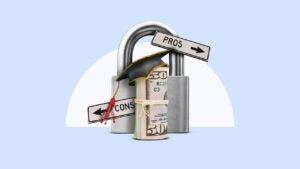What is a private student loan?

Key takeaways
- Private student loans can help cover any funding gaps for college — ideally, after you’ve exhausted your federal loan eligibility and applied for grants and scholarships.
- Private loans have flexible repayment options and eligibility requirements, but they often have higher interest rates than federal loans.
- Another disadvantage of private student loans is that, unlike federal student loans, they don’t come with access to income-driven repayment plans or loan forgiveness programs.
- When choosing a private student loan, compare rates and terms from as many lenders as possible to get the best deal for your situation.
When grants, scholarships and federal student loans aren’t enough to cover college costs, private student loans can help make up the difference. For the 2024-25 academic year, the average cost of tuition and fees for in-state undergraduate students at public four-year colleges is $11,610, or $30,780 for out-of-state students, according to the most recent data from College Board.
With such high costs, many students must turn to private student loans, which are offered by private institutions like banks and online lenders. Going beyond the private student loan definition and understanding their pros and cons can help you decide whether they’re the best financing option for you.
Understanding private student loans
When you apply for a private student loan, a lender typically makes a credit inquiry to assess the risk of lending you money. If you have poor credit or a thin credit profile, it can be tough to qualify without a co-signer.
While federal loans have student loan limits, many private student loan companies allow you to borrow up to your school’s cost of attendance, minus any federal aid you received. This can be especially helpful when dealing with out-of-state tuition costs.
Private student loans also often have the same grace period as federal student loans, which is six months after graduating, dropping below part-time status or leaving school. They also have a variety of repayment terms, often ranging from five to 20 years.
Unlike federal loans that only come with fixed rates, private student loans have fixed or variable rates. Starting interest rates for fixed-rate loans are typically higher than for variable-rate loans. However, if you choose a fixed rate, the rate you receive upon accepting your loan is the rate you’ll pay for the duration. If you choose a variable rate, the rate you receive could change regularly, potentially making your loan more expensive over time.
Pros and cons of private student loans
Private student loans have many benefits, but you should also consider the downsides before signing up.
Pros
- High loan amounts. Federal student loans have annual caps that can be as low as $5,500 for undergraduate students. After you max out your federal student loans, you may still need money to cover additional costs. Private student loans can help to fill in the gaps.
- Quick application process. While federal student loans require borrowers to fill out the Free Application for Federal Student Aid (FAFSA), private student loans do not. You can apply for most private student loans online in just a few minutes without providing nearly as much information.
- Available for part-time college students. You have to be enrolled in school at least half time to qualify for federal loans, but some private lenders, like Sallie Mae, will let you borrow money if you attend school less often than that.
- Competitive interest rates. Student loan interest rates and loan terms can be incredibly generous for borrowers with excellent credit or a qualified co-signer. If you want to pay as little interest as possible on your student loans, private student loans may be the best option.
Cons
- Shorter repayment timelines. Private student loans tend to come with shorter repayment timelines than federal loans. Through some government programs, you can adjust your student loan repayment to 25 or 30 years, while most private student loans have caps of 15 years for undergraduates.
- No government-sponsored public service or teacher loan forgiveness. Programs like Public Service Loan Forgiveness (PSLF) are not available for private loans.
- No income-driven payment plans. Some federal student loans can be repaid on income-driven repayment plans, which adjust your monthly payment based on your income. Private student loans typically only have traditional repayment options.
- No government deferment or forbearance. While some private student loans have student relief options if you’re having trouble making payments, these programs are not nearly as robust as what federal loans offer.
Federal vs. private student loans
|
Federal loans |
Private loans |
|
|
Type of interest rates |
Fixed rates only |
Variable or fixed interest rates |
|
Loan amounts |
Up to $57,500 aggregate for undergraduates, up to the full cost of attendance for graduates |
Up to the full cost of attendance with most lenders |
|
Grace period |
6 months |
Up to 12 months |
|
Co-signer required? |
No |
Often required |
|
Repayment terms |
Standard term is 10 years; income-driven repayment plans available to extend repayment |
5 to 20 years |
|
Loan forgiveness programs |
Available for all borrowers |
None |
|
Need good credit to qualify? |
No |
Yes |
|
Best for |
Most borrowers |
Borrowers who have reached their federal loan limit |
When to consider getting a private student loan
You should max out your federal student loans before turning to private student loans. That way, you’ll have access to income-driven repayment plans, loan forgiveness programs and extended deferment and forbearance periods.
If you still need money to cover tuition or other expenses, consider private student loans. Remember to only borrow what you need; the more you borrow now, the more you’ll have to pay back after you graduate.
Other scenarios where private loans make sense include:
- Your expenses suddenly change. If you’ve already maxed out federal student loans and your college expenses suddenly go up, private student loans can help you access more funding quickly.
- You don’t qualify for federal loans. International students may not qualify for federal loans, so private loans could be the only source of funding.
- You have a specific plan to repay the money you borrow in a short amount of time. If you have a plan to repay your student loans over a few years, private student loans could end up being cheaper overall.
How to choose the best private student loan
It’s important to shop around before you decide on a lender. Compare loan options from multiple lenders — don’t just go with the first private student loan company you find. These steps can help you find the best one:
- Decide between a fixed and variable rate. Many private lenders offer the choice between a fixed and a variable rate, but some offer only one or the other. Consider your priorities ahead of time so you know what to look for.
- Compare interest rates. Interest rates determine how much your student loan will cost in total. Compare private student loan rates to find the lowest one. Take advantage of prequalification offers so you can see what rate you qualify for without incurring a hard credit check on your credit report.
- Apply for the right loan for your degree. Some student loans are created for students in specific programs. For example, you will need to explore specific private loan programs if you’re pursuing an MBA or planning to obtain a medical school loan.
- Research each lender’s reputation. A lender’s reputation is just as important as its interest rate when it comes to applying for a private student loan. There are lots of reputable third parties you can use when looking into a lender’s reviews, like the Better Business Bureau (BBB).
- Browse benefits. Some lenders offer specific benefits, like no late fees or long grace periods. Some might offer programs that make payments more manageable after graduation.
- Ensure that the lender accepts your school. While a lender might sound good on paper, some may have a specific list of approved schools. To find out if your school qualifies, you can check the lender’s website or call to inquire.
Bottom line
While private student loans may offer more flexibility with loan amounts and repayment terms, they also come with higher interest rates and lack the forgiveness programs offered by federal loans. Exhaust all options for federal aid before turning to private loans and carefully compare offers from multiple lenders to find the best fit.
Ultimately, it is important to only borrow what is necessary and to fully understand the terms and conditions of any student loan before accepting it. Choose the loan that best suits your needs and educational goals.









